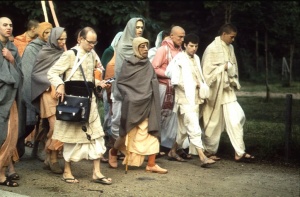CC Madhya 12.215 (1975): Difference between revisions
(Vanibot #0027: CCMirror - Mirror CC's 1996 edition to form a basis for 1975) |
(Vanibot #0020: VersionCompareLinker - added a link to the Version Compare feature) |
||
| Line 2: | Line 2: | ||
<div style="float:left">'''[[Sri Caitanya-caritamrta (1975)|Śrī Caitanya-caritāmṛta (1975)]] - [[CC Madhya (1975)|Madhya-līlā]] - [[CC Madhya 12 (1975)|Chapter 12: The Cleansing of the Guṇḍicā Temple]]'''</div> | <div style="float:left">'''[[Sri Caitanya-caritamrta (1975)|Śrī Caitanya-caritāmṛta (1975)]] - [[CC Madhya (1975)|Madhya-līlā]] - [[CC Madhya 12 (1975)|Chapter 12: The Cleansing of the Guṇḍicā Temple]]'''</div> | ||
<div style="float:right">[[File:Go-previous.png|link=CC Madhya 12.214 (1975)|Madhya-līlā 12.214]] '''[[CC Madhya 12.214 (1975)|Madhya-līlā 12.214]] - [[CC Madhya 12.216 (1975)|Madhya-līlā 12.216]]''' [[File:Go-next.png|link=CC Madhya 12.216 (1975)|Madhya-līlā 12.216]]</div> | <div style="float:right">[[File:Go-previous.png|link=CC Madhya 12.214 (1975)|Madhya-līlā 12.214]] '''[[CC Madhya 12.214 (1975)|Madhya-līlā 12.214]] - [[CC Madhya 12.216 (1975)|Madhya-līlā 12.216]]''' [[File:Go-next.png|link=CC Madhya 12.216 (1975)|Madhya-līlā 12.216]]</div> | ||
{{CompareVersions|CC|Madhya 12.215|CC 1975|CC 1996}} | |||
{{RandomImage}} | {{RandomImage}} | ||
==== TEXT 215 ==== | ==== TEXT 215 ==== | ||
| Line 11: | Line 10: | ||
<div class="verse"> | <div class="verse"> | ||
:yata piye tata tṛṣṇā bāḍhe nirantara | :yata piye tata tṛṣṇā bāḍhe nirantara | ||
:mukhāmbuja | :mukhāmbuja chāḍi' netra nā yāya antara | ||
</div> | </div> | ||
| Line 18: | Line 17: | ||
<div class="synonyms"> | <div class="synonyms"> | ||
yata—as much; piye—they drink; tata—so much; tṛṣṇā—thirst; | yata—as much; piye—they drink; tata—so much; tṛṣṇā—thirst; bāḍhe—increases; nirantara—incessantly; mukha-ambuja—the lotuslike face; chāḍi'—giving up; netra—the eyes; nā—do not; yāya—go; antara—separate. | ||
</div> | </div> | ||
| Line 34: | Line 33: | ||
In the Laghu-bhāgavatāmṛta (1.5.538), Śrīla Rūpa Gosvāmī has described the beauty of the Lord in this way: | In the Laghu-bhāgavatāmṛta (1.5.538), Śrīla Rūpa Gosvāmī has described the beauty of the Lord in this way: | ||
asamānordhva-mādhurya- | |||
taraṅgāmṛta-vāridhiḥ | |||
jaṅgama-sthāvarollāsi- | |||
:rūpo gopendra-nandanaḥ | |||
"The beauty of the son of Mahārāja Nanda is incomparable. Nothing is higher than His beauty, and nothing can equal it. His beauty is like waves in an ocean of nectar. This beauty is attractive both for moving and for nonmoving objects." | |||
Similarly, in the Tantra-śāstra, there is another description of the Lord's beauty: | |||
Similarly, in the | |||
kandarpa-koṭy-arbuda-rūpa-śobha- | |||
:nīrājya-pādābja- | :nīrājya-pādābja-nakhāṁ calasya | ||
:kutrāpy adṛṣṭa-śruta-ramya-kānter | :kutrāpy adṛṣṭa-śruta-ramya-kānter | ||
:dhyānaṁ paraṁ nanda-sutasya vakṣye | :dhyānaṁ paraṁ nanda-sutasya vakṣye | ||
"I shall relate the supreme meditation upon Lord Śrī Kṛṣṇa, the son of Nanda Mahārāja. The tips of the toes of His lotus feet reflect the beauty of the bodies of unlimited millions of Cupids, and His bodily luster has never been seen or heard of anywhere." | |||
One may also consult Śrīmad-Bhāgavatam ( | |||
One may also consult Śrīmad-Bhāgavatam (10.29.14) in this connection. | |||
</div> | </div> | ||
Latest revision as of 07:11, 27 January 2020

A.C. Bhaktivedanta Swami Prabhupada
TEXT 215
- yata piye tata tṛṣṇā bāḍhe nirantara
- mukhāmbuja chāḍi' netra nā yāya antara
SYNONYMS
yata—as much; piye—they drink; tata—so much; tṛṣṇā—thirst; bāḍhe—increases; nirantara—incessantly; mukha-ambuja—the lotuslike face; chāḍi'—giving up; netra—the eyes; nā—do not; yāya—go; antara—separate.
TRANSLATION
As their eyes began to drink the nectarean honey of His lotus face, their thirst increased. Thus their eyes did not leave Him.
PURPORT
In the Laghu-bhāgavatāmṛta (1.5.538), Śrīla Rūpa Gosvāmī has described the beauty of the Lord in this way:
asamānordhva-mādhurya- taraṅgāmṛta-vāridhiḥ jaṅgama-sthāvarollāsi-
- rūpo gopendra-nandanaḥ
"The beauty of the son of Mahārāja Nanda is incomparable. Nothing is higher than His beauty, and nothing can equal it. His beauty is like waves in an ocean of nectar. This beauty is attractive both for moving and for nonmoving objects."
Similarly, in the Tantra-śāstra, there is another description of the Lord's beauty:
kandarpa-koṭy-arbuda-rūpa-śobha-
- nīrājya-pādābja-nakhāṁ calasya
- kutrāpy adṛṣṭa-śruta-ramya-kānter
- dhyānaṁ paraṁ nanda-sutasya vakṣye
"I shall relate the supreme meditation upon Lord Śrī Kṛṣṇa, the son of Nanda Mahārāja. The tips of the toes of His lotus feet reflect the beauty of the bodies of unlimited millions of Cupids, and His bodily luster has never been seen or heard of anywhere."
One may also consult Śrīmad-Bhāgavatam (10.29.14) in this connection.